Rafiqul Islam
Dept. of Population Science and Human Resource Development, University of Rajshahi, Rajshahi, 6205 Bangladesh
Correspondence to: Rafiqul Islam , Dept. of Population Science and Human Resource Development, University of Rajshahi, Rajshahi, 6205 Bangladesh.
| Email: |  |
Copyright © 2012 Scientific & Academic Publishing. All Rights Reserved.
Abstract
In this paper, the population for Muslim of Urban region in Bangladesh is projected by using the exponential growth rate method. For this connection, the information of data for Urban Muslim population for male and female of Bangladesh is obtained from 1991 and 2001 censuses. The projections are computed in three stage procedures. In the first stage, the predictions are computed using negative exponential growth model estimated by the Quasi-Newton method using STATISTICA for the years 1991 and 2001. Using the cross validation predictive power (CVPP) criterion and , the shrinkage coefficient ( ) is constructed. The shrinkage coefficient determines the adequacy of the first phase prediction. In the second stage, these predicted values are used to estimate the growth rate, for different age groups, by using the exponential growth rate method. In the third stage, that is, finally considering the observed population for Muslim of Urban region in Bangladesh for the Census year 2001 as the base population and using the estimated exponential growth rate, at different age groups, of the second stage estimation, the projections for the population of Muslim of Urban region are estimated for the years 2002 through to 2021 employing exponential growth rate method.
) is constructed. The shrinkage coefficient determines the adequacy of the first phase prediction. In the second stage, these predicted values are used to estimate the growth rate, for different age groups, by using the exponential growth rate method. In the third stage, that is, finally considering the observed population for Muslim of Urban region in Bangladesh for the Census year 2001 as the base population and using the estimated exponential growth rate, at different age groups, of the second stage estimation, the projections for the population of Muslim of Urban region are estimated for the years 2002 through to 2021 employing exponential growth rate method.
Keywords:
Urban Muslim Population of Bangladesh, Exponential Model, Cross- validity prediction power (CVPP), Exponential Growth Rate Method, t-test, F-test
1. Introduction
Bangladesh is Muslim dominant country and approximately 90% population of Bangladesh is Muslim. The Muslim population was enlarged 10.9% in 1911 over 1901. On the other hand, comparatively lesser increasing trends have been found of 6.8% and 9.2% in 1921 and in 1931 respectively in accordance with high mortality, floods, droughts, epidemic, plague, pandemic and others various catastrophic diseases. And, it was risen 26.9% in 1961 over 1951 and 49.3% in 1974 over 1961. It is the cause that the emigrated number of Hindus after independence of 1947 was comparatively larger than the immigrated number of Muslims from India. And, it was increased approximately 18.3% in 2001 census [1].Population census usually carried out at ten year interval of time is the most important source of data on size, structure and distribution of population by religion or any other demographic and socio-economic characteristics in Bangladesh. The Government and Non-government organizations do require the up-to-the-minute information on population. Consequently, one can easily use to make reasonable plans for development for the present and future time. The Government and demographers are not only the users of population but also trade unions, social organizations, university and other social research institutes and centres, market research analysis, housing developers and business communities frequently do need these estimates for their individual purposes. Moreover, population or population by religion (Muslim), age and sex serves as the denominator for the estimation of socio-demographic, health and development related indicators.Furthermore, projected population is important and needed for sustainable development in the up to minute nuclear-technology, modernization and industrialization era. Indeed, population projections provide a signal to the planners as how the economy is to be adjusted according to the population and also how the population should be adjusted in accordance with the economy. Population projections can point up the probable population intensification and structural consequences of such presumed development. It was observed that age configuration for population of both sexes in Bangladesh follows negative exponential model[2]. It was investigated that the age structure for male, female and both sexes population of Bangladesh followed either negative exponential model or modified negative exponential model [3,4]. Islam et al.[5] observed that age construction for male population of Bangladesh in 1991 census follows modified negative exponential model. It was showed that proportion of married women of Bangladesh in the reproductive time-span follow cubic polynomial model[6].Therefore, the fundamental aims and objectives of this study are given below:i to build up mathematical models for the Urban Muslim population for male and female by age group in years for the census years of 1991 and 2001 and to apply CVPP to test the adequacy of the model, andii then to project Urban Muslim population for male and female by ages in Bangladesh by employing exponential growth rate method at different ages.This paper is structured as follows. Introduction is included in the first section. Data and data sources of this study are presented in section 2. Section 3 describes the methods and methodological issues in which smoothing of age data by free hand curve method, model fitting, model accuracy test, F-test and exponential growth rate method. Application of model and discussion of results of this paper are reported in section 4. Finally, section 5 concludes the conclusion and concluding remarks of the manuscript.
2. Data and Data Sources of this Study
To fulfill the aforesaid objectives, the data on Urban Muslim population by sex and age groups in Bangladesh is taken from of the censuses of 1991[7] and 2001[1]. These have been utilized as raw resources of the present study and exposed in Table 1 and Table 2 for the censuses of 1991 and 2001 respectively.
3. Methods and Methodological Issues
3.1. Smoothing of Age Data by Free Hand Curve Method
It is observed that there is some sort of unexpected distortions in the data aggregate if the Urban Muslim population by age group is to be placed on graph paper. Therefore, an adjustment is needed to diminish these unpredicted distortions before going to fit the models to the data. As a result, a modification is made, that is, quinquennial age wise data is smoothened in the current study by Free Hand Curve Method. After that, the smoothed data have been used to fit mathematical model and these smoothed data for male and female Muslim population of the censuses of 1991 and 2001 are launched in Table 1 and Table 2 respectively.
3.2. Model Fitting
Using the scattered plot of smoothed age structure for Urban for male and female Muslim population by ages in years, it appears that this age wise population is negative exponentially distributed. Therefore, a modified negative exponential model is considered for the first stage prediction and the mathematical form of this model is given by | (1) |
Here, x represents the middle value of the age group; y represents the Urban Muslim population; a, b and c are unknown parameters and u is the stochastic disturbance term of the model. These models are constructed by handling the software STATISTICA.
3.3. Model Accuracy Test
In this paper, to assess the accuracy and reliability of these models, the CVPP,  , is applied. The mathematical formula for CVPP is specified by
, is applied. The mathematical formula for CVPP is specified by In which, n is the number of classes, k is the number of regressors in the fitted model and the cross-validated R is the correlation between observed and predicted values of the predictand variable [8]. The shrinkage and contraction of the model is the positive value of (
In which, n is the number of classes, k is the number of regressors in the fitted model and the cross-validated R is the correlation between observed and predicted values of the predictand variable [8]. The shrinkage and contraction of the model is the positive value of ( - R2); where
- R2); where is CVPP & R2 is the coefficient of determination of the model. 1-shrinkage is the stability of R2 of the model. The estimated CVPP related to their R2 and information on model fittings are presented in Table 3. Note that CVPP was also employed as model validation or accuracy test by Islam [3, 4] and Islam et al. [2, 5]
is CVPP & R2 is the coefficient of determination of the model. 1-shrinkage is the stability of R2 of the model. The estimated CVPP related to their R2 and information on model fittings are presented in Table 3. Note that CVPP was also employed as model validation or accuracy test by Islam [3, 4] and Islam et al. [2, 5]
3.4. F-test
To find out the measure of overall significance of the fitted models as well as the significance of R2 , the F-test is employed here[9].
3.5. Exponential Growth Rate Method
For the estimation of growth rate and projection of population, exponential growth rate method is considered in this study and the mathematical form of this method is given by | (2) |
Where,  is the predicted initial population at time t1 in the age group a to a+5,
is the predicted initial population at time t1 in the age group a to a+5,  = the predicted terminal population at time t2 in the age group a to a+5,
= the predicted terminal population at time t2 in the age group a to a+5,  is the inter censual annual growth rate in the age group a to a+5 and
is the inter censual annual growth rate in the age group a to a+5 and  = the time interval between inter censual period.For the second phase procedure, the estimation of
= the time interval between inter censual period.For the second phase procedure, the estimation of  is computed for different age groups from (2) as follows.
is computed for different age groups from (2) as follows. | (3) |
Years 1991 and 2001 are considered as the initial and the terminal populations respectively in estimating the inter censual annual age specific growth rates by using equation (3).Finally, that is, for the third phase in view of projecting purpose, 2001 census Urban Muslim observed population for male and female by age group is considered as base population and inter censual annual growth rate by age groups during 1991 – 2001 obtained in the second phase is used in this study assuming fertility and mortality remaining unaltered during the projected period. Actually, age wise projected population of Urban Muslim is obtained from equation (2) using age specific growth rates estimated of the second phase and observed initial population of 2001 census running equation (2) successively 20 times.
4. Application of Model and Discussion of Results
The modified negative exponential model is chosen to fit the models for Urban Muslim population, Bangladesh for the census years 1991 and 2001 and the fitted models are described below: | (1) |
 | (2) |
 | (3) |
 | (4) |
t-stats (-12.817) (23.44393) (542.8209)The results on model fittings and estimated CVPP alike to their R2 of these models are revealed in Table 3. From this table it appears that all the fitted models (1), (2), (3) and (4) are highly cross- validated and their corresponding shrinkage coefficients (λ) are 0.00327, 0.001547, 0.00117 and 0.00076. These imply that the fitted models (1), (2), (3) and (4) will be stable more than 98%, 99%, 99% and 99% respectively. As well, it is found that the parameters of the fitted models (1)-(4) are highly statistically significant with proportion of variance is explained more than 98%. The stability for R2 of these models is more than 99%. The enumerated values of F statistic for these models are shown in the 9th columns of Table 3 while the analogous tabulated values of these models are demonstrated in the last column of the same table at 1% level of significance. These results are indicated that these models and their corresponding to R2 are highly statistically significant and hence, these are well fitted to the data. The graph of observed, smoothed and predicted Urban Muslim population by age group in years for 1991 and 2001 census years of Bangladesh are depicted in Figure 1, Figure 2, Figure 3 and Figure 4 respectively.It is to be noted that other models, i. e., linear, log linear, semi-log linear and polynomial model were also tried to employ here but seems to be worse fitted with respect to their coefficient of determination and shrinkage coefficients (λ). For that reason, the outcomes of those models were not publicized here.For the second phase estimation, age specific inter censual annual growth rates during 1991-2001 are estimated by applying exponential growth rate method at each age group using the predicted values obtained by first phase procedure and these growth rates are demonstrated in Table 4 and displayed in Figure 5. From the table it is found that growth rate for male and female populations are positive that indicating that population are increasing during the inter censual period 1991-2001. Moreover, it is seen from the figure that these rates are showing increasing trends in accordance with ages.Projected Urban Muslim population for male and female by age group are estimated employing exponential growth rate method using predicted values of the fitted models and presented in Table 4 and Table 5 respectively. It is found that the pattern of male and female Urban Muslim population at each year is downward due to ages. But the trend of these is increasing, i.e., upward with passing of time all over the period 1991-2021.It is note that projected Urban Muslim population for both sexes by age group is easily obtained by adding the projected male and female Urban Muslim population by age group in years.Table 1. Observed, Smoothed and Predicted Muslim Population by Age Group for Male and Female of Urban Area in Bangladesh in 1991 Census
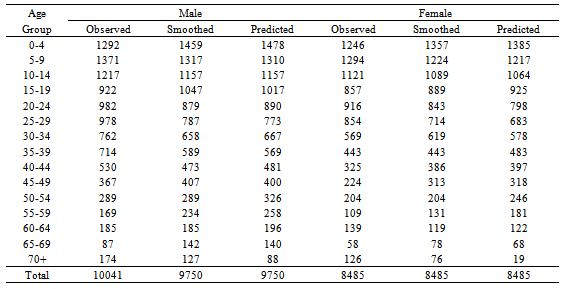 |
| |
|
Table 2. Observed, Smoothed and Predicted Muslim Population by Age Group for Male and Female of Urban Area in Bangladesh in 2001 Census
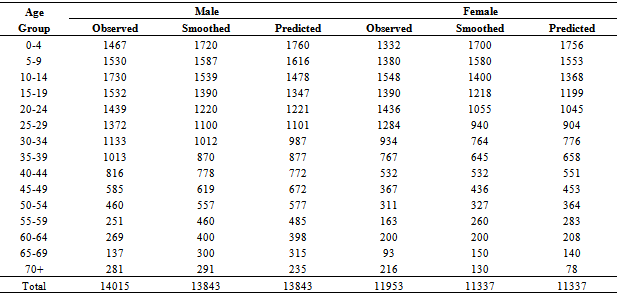 |
| |
|
Table 3. The Results of CVPP and Information on Model Fittings
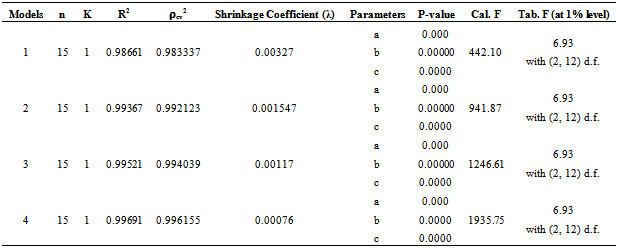 |
| |
|
Table 4. Estimated Growth Rate for Male and Female Population at each Age Group
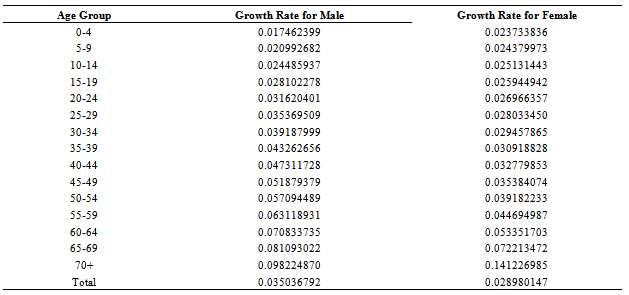 |
| |
|
Table 5. Projected Male Muslim Population by Age Group of Urban Area in Bangladesh during 2002-2021 (in thousands)
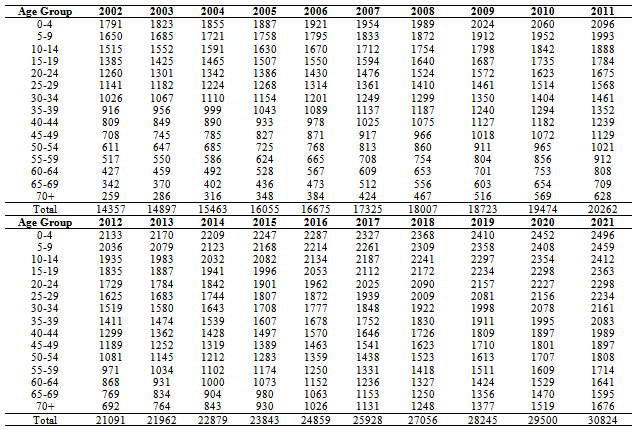 |
| |
|
Table 6. Projected Female Muslim Population by Age Group of Urban Area in Bangladesh during 2002-2021 (in thousands)
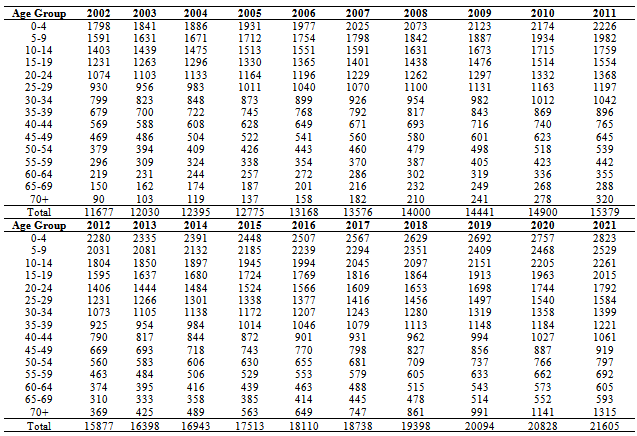 |
| |
|
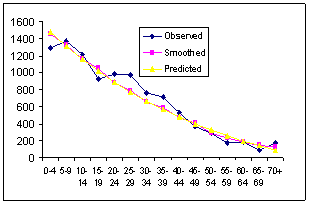 | Figure 1. Observed, Smoothed and Predicted Muslim Population by Age Group for Male of Urban area in Bangladesh in 1991 Census. X axis represents Age Group and Y axis represents Male Population |
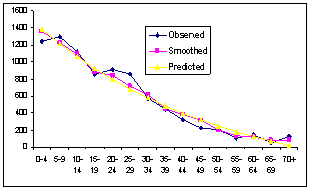 | Figure 2. Observed, Smoothed and Predicted Muslim Population by Age Group for Female of Urban area in Bangladesh in 1991 Census. X axis represents Age and Y axis represents Female Population |
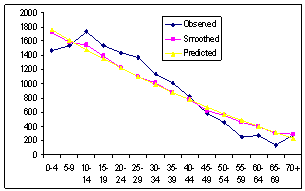 | Figure 3. Observed, Smoothed and Predicted Muslim Population by Age Group for Male of Urban area in Bangladesh in 2001 Census. X axis represents Age Group and Y axis represents Male Population |
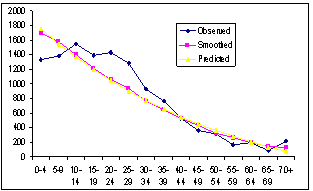 | Figure 4. Observed, Smoothed and Predicted Muslim Population by Age Group for Female of Urban area in Bangladesh in 2001 Census. X axis represents Age and Y axis represents Female Population |
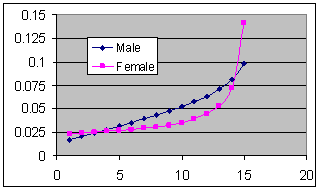 | Figure 5. Age Specific Growth Rates for Male and Female for Muslim of Urban Region of Bangladesh. X axis represents Age Group and Y axis represents Growth Rate |
5. Conclusions
It is observed that the age pattern of Urban Muslim population for the censuses of 1991 and 2001 follow three parameters modified negative exponential model. It is hoped that one can use this predicted Urban Muslim population by age group for further advanced study as more smoothened data than observed. It is expected that these projected Urban Muslim population for the duration of the period 2002 – 2021 might be more used for higher developed research as well as it can be used in the planning of government and NGOs to boost up the socio-economic, demographic, and health related characteristics and other social indicators at the same time as most of the cases the population is normally used as denominator for the estimation of various socio-economic, demographic, health related and development indicators. Moreover, population projections are required and used for setting employment target, for manpower planning, for planning how to increase productivity, for opening schools, for teachers training, for planning expansion of hospitals, for supply of goods and services of various types, for providing inputs to agriculture and industry, for calculating food requirements, for planning allotment system, for looking after dietary needs, for planning housing creation programs, for planning transportation requirements, for planning energy supply needs, for developing mining, for planning information and communication technology to strengthen the knowledge in this sector to vie the competitive global market, for conducting and scheduling elections, for planning the institute of law and order mechanism, etc. Further research may be done using world population data or Asian data.
References
| [1] | BBS (2003). Bangladesh Population Census 2001, National Report, Government of the People’s Republic of Bangladesh, Dhaka. |
| [2] | Islam, Md. Rafiqul, Islam, Md. Nurul, Ali, M. Korban & Mondal, Md. Nazrul Islam (2005). Indirect Estimation and Mathematical Modeling of Some Demographic Parameters of Bangladesh, The Oriental Anthropologist, Vol. 5(2), Page 163 - 171. |
| [3] | Islam, Md. Rafiqul (2003). Modeling of Demographic Parameters of Bangladesh-An Empirical Forecasting, Unpublished Ph.D. Thesis, Rajshahi University. |
| [4] | Islam, Md. Rafiqul (2005). Construction of Female Life Table from Male Widowed Information of Bangladesh, Pakistan J. of Statistics, Vol. 21(3), Page 275-284. |
| [5] | Islam, Md. Rafiqul, Islam, Md. Nurul, Ali, Md. Ayub & Mostofa, Md. Golam (2003). Construction of Male Life Table from Female Widowed Information of Bangladesh, International J. of Statistical Sciences, Vol. 2, Dept. of Statistics, University of Rajshahi, Bangladesh, Page 69-82. |
| [6] | Islam, Md. Rafiqul (2004). Indirect Estimation of fertility Parameters of Bangladesh, J. of Indian Anthropological Society, Vol. 39 (2), Page 195-202. |
| [7] | BBS (1994). Bangladesh Population Census 1991, Vol. 1, National Series, Government of the People’s Republic of Bangladesh, Dhaka. |
| [8] | Stevens, J. (1996). Applied Multivariate Statistics for the Social Sciences, Third Edition, Lawrence Erlbaum Associates, Inc., Publishers, New Jersey. |
| [9] | Gujarati, Damodar N. (1998). Basic Econometrics, Third Edition, McGraw Hill, Inc., New York. |
| [10] | Shryock, H. S, J. S. Siegel and Associates (1975). The Methods and Materials of Demography, Vol. I & II, U.S. Government Printing Office, Washington. |

 ) is constructed. The shrinkage coefficient determines the adequacy of the first phase prediction. In the second stage, these predicted values are used to estimate the growth rate, for different age groups, by using the exponential growth rate method. In the third stage, that is, finally considering the observed population for Muslim of Urban region in Bangladesh for the Census year 2001 as the base population and using the estimated exponential growth rate, at different age groups, of the second stage estimation, the projections for the population of Muslim of Urban region are estimated for the years 2002 through to 2021 employing exponential growth rate method.
) is constructed. The shrinkage coefficient determines the adequacy of the first phase prediction. In the second stage, these predicted values are used to estimate the growth rate, for different age groups, by using the exponential growth rate method. In the third stage, that is, finally considering the observed population for Muslim of Urban region in Bangladesh for the Census year 2001 as the base population and using the estimated exponential growth rate, at different age groups, of the second stage estimation, the projections for the population of Muslim of Urban region are estimated for the years 2002 through to 2021 employing exponential growth rate method.

 , is applied. The mathematical formula for CVPP is specified by
, is applied. The mathematical formula for CVPP is specified by In which, n is the number of classes, k is the number of regressors in the fitted model and the cross-validated R is the correlation between observed and predicted values of the predictand variable [8]. The shrinkage and contraction of the model is the positive value of (
In which, n is the number of classes, k is the number of regressors in the fitted model and the cross-validated R is the correlation between observed and predicted values of the predictand variable [8]. The shrinkage and contraction of the model is the positive value of ( - R2); where
- R2); where is CVPP & R2 is the coefficient of determination of the model. 1-shrinkage is the stability of R2 of the model. The estimated CVPP related to their R2 and information on model fittings are presented in Table 3. Note that CVPP was also employed as model validation or accuracy test by Islam [3, 4] and Islam et al. [2, 5]
is CVPP & R2 is the coefficient of determination of the model. 1-shrinkage is the stability of R2 of the model. The estimated CVPP related to their R2 and information on model fittings are presented in Table 3. Note that CVPP was also employed as model validation or accuracy test by Islam [3, 4] and Islam et al. [2, 5]
 is the predicted initial population at time t1 in the age group a to a+5,
is the predicted initial population at time t1 in the age group a to a+5,  = the predicted terminal population at time t2 in the age group a to a+5,
= the predicted terminal population at time t2 in the age group a to a+5,  is the inter censual annual growth rate in the age group a to a+5 and
is the inter censual annual growth rate in the age group a to a+5 and  = the time interval between inter censual period.For the second phase procedure, the estimation of
= the time interval between inter censual period.For the second phase procedure, the estimation of  is computed for different age groups from (2) as follows.
is computed for different age groups from (2) as follows.









 Abstract
Abstract Reference
Reference Full-Text PDF
Full-Text PDF Full-Text HTML
Full-Text HTML




